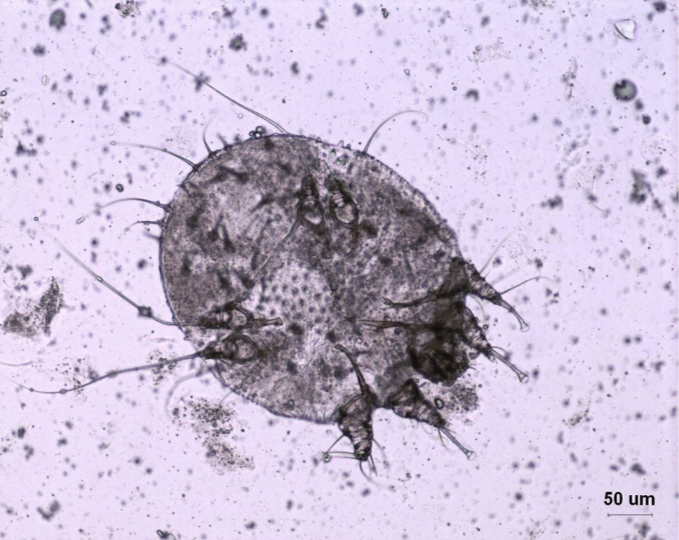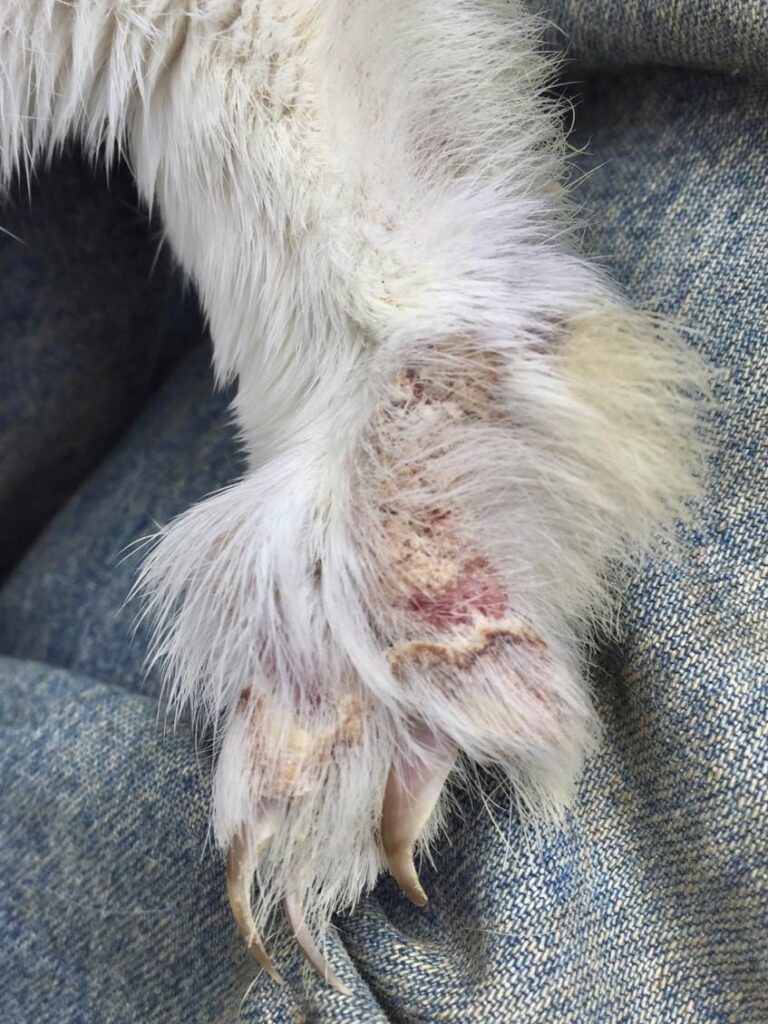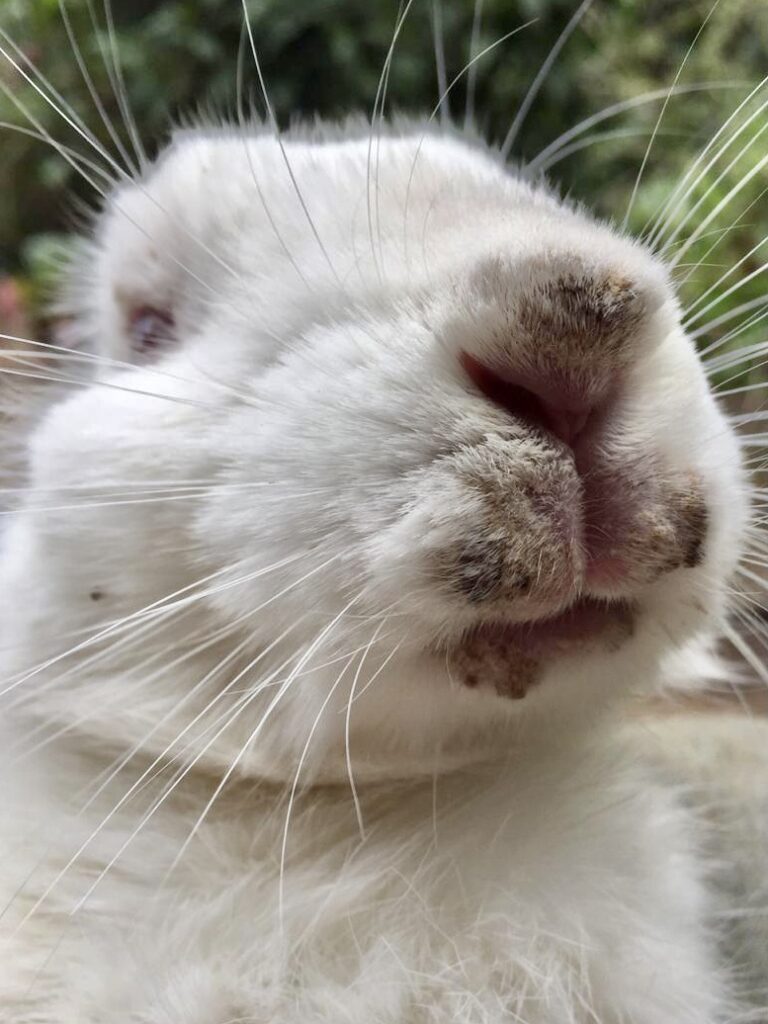In the five years I’ve been keeping rabbits, I’ve seen a variety of health complications arise, but certainly the most common issue I’ve dealt with is rabbit mites, also known as sarcoptic mange, or Sarcoptes scabiei var. cuniculi.
Sarcoptes scabiei is a mite that burrows deep into the epidermis of its host causing severe itching, formation of crusts & scales, as well as redness, dryness, & thickening of the skin in the affected areas. The rabbits’ repetitive scratching and chewing at infested skin breaks open the crusts and causes raw, open lesions. These mites typically affect edges of the outer ear, lips, nose, legs, toes, feet, and the areas around the genitals.

Sarcoptic mites are highly contagious through contact with an infested animal. These parasites affect several mammalian hosts, including dogs, cats, rats, and rabbits (Hofing & Kraus, 1994).
Persisting or severe infestations can cause weakened immune system, susceptibility to secondary infections, anorexia, lethargy, and weight loss — all of which can cause death, especially in young or very weak animals.
Treatment can be difficult as sarcoptic mange can be quite persistent. I lost several rabbits to complications from chronic mite infestations before I finally developed a protocol that worked effectively. Unfortunately, none of the botanical treatments I trialed worked to eradicate mites.

What I have found to be effective is high dose treatments of topical Ivermectin at a dose of 7 drops per kg of body weight, repeated weekly 3 times. Most of the scientific studies I’ve read use ivermectin subcutaneously to treat mites. But, repeated injections can be particularly upsetting for rabbits, not to mention more difficult to administer solo, so I do prefer the topical application. Note that repeating the treatment 3 times at an interval of 7 days is essential for the success of this protocol.
Supplementing nutrition during all stages of active infestation is another key piece to ensure that rabbits aren’t overly depleted and weakened, which will impair recovery. We typically give oats mixed with rabbit mineral blend or “balanceado” — rabbit food pellets that contain vitamins, minerals, fiber, and protein in the proper amounts to promote overall health.
I have also treated the lesions in affected areas topically to prevent infection and promote healing with the sap of sangre de drago (Croton lechleri).
It’s important to note that to fully eradicate an infestation on a homestead or farm treating all affected animals, as well as cleaning and disinfecting the areas they frequent is an important part of controlling mites and preventing future infestations. Transmission through clothing is rare, but it is advised to keep garments exposed to affected animals in a plastic bag for 72 hours, or wash it at a temperature of at least 50 degrees Celsius (Nogales et al., 2020).
There is a good deal of scientific literature discussing successful ivermectin protocols for resolving mite infestations. Several Indian studies have showed that Ivermectin, injected subcutaneously, is an effective treatment for sarcoptic mange in rabbits. A dose of 0.2-0.4 mg/kg of body weight is generally considered to be safe and effective (Kumar et al., 2018).
In a 2014 study, infested rabbits were treated with Ivermectin 1% w/v, which was injected subcutaneously at a dose of 400 μg/kg of body weight every 7 days, 3 times. This study also included supportive treatments, including medication for relieving itching and skin discomfort (Pheniramine maleate) and supplementation of Vitamin B1, B6, & B12, as well as Omega-3 & Omega-6 fatty acids. Following this protocol, significant improvement was observed after one week and the rabbits recovered completely by 28 days (Kachhawa et al., 2013).
In a 2018 study, affected rabbits were treated with subcutaneous injections of Ivermectin at a dose of 200 μg/kg weekly for 3 weeks. Multivitamins were given as a supportive therapy and a solution was applied topically to the lesions to promote healing & prevent infection (5% betadin solution). Following this protocol, the lesions had improved significantly within 14 days. After 3 weeks of treatment, they had fully healed and there was no presence of mites (Kumar et al., 2018).
A 2019 study found that one dose of long acting Ivermectin (3.15% w/v) injected subcutaneously at a dose of 700 μg/kg completely eliminated Sarcoptes scabiei mites in infested rabbits. Supplemental zinc and vitamins helped the rabbits’ condition improve more quickly (Sharun, et al., 2019).
In another Indian study conducted in 2020, rabbits were treated with ivermectin subcutaneously at a dose of 200 μg/kg administered weekly for three weeks. Topical treatments to promote healing & prevent infection (5% betadine solution), as well as benzyl benzoate, a medication used to treat mites, were applied topically twice a day. An anti-inflammatory medication (Meloxicam) and antihistamine to reduce itching (chlorpheniramine maleate) were also given as supportive therapies to speed up the healing process. After 3 weeks, the lesions had improved and there was no presence of mites (Thakre et al., 2020).
A 2019 Kenyan study found ivermectin and liquid paraffin both effectively treated sarcoptic mite infestations. Rabbits in the study either received two ivermectin injections 14 days apart or liquid paraffin applied daily for 21 days, when the lesions had cleared. While rabbits treated with liquid paraffin did have subsequent infestations, Ogolla et al. state, “The use of liquid paraffin against rabbit mange should be promoted as it is easily accessible, relatively affordable, has no known side effects, and will contribute to reduction in use of antiparasiticides such as ivermectin thereby minimising acaricide resistance and accumulation of their residues in animal products (2019).
Selemectin, commonly available under the brand name Revolution, is another antiparastic that can be used to treat Sarcoptes scabiei. A 2007 study conducted in Turkey found that selemectin successfully eradicated mites in affected rabbits. (Kurtdede et al., 2007). This online calculator can help to determine the correct dose.
A 2009 study treated infested rabbits with a dose of 8-14mg/kg of body weight of topical Selemectin — one 30mg (0.25ml) tube applied between the shoulders — and repeated this dose 30 days later. They also began cleaning out the rabbits cages and replacing their bedding daily, but did not apply any anti-parasitic chemicals to the rabbits’ housing. Within 30 days, the lesions had resolved and there was no presence of mites (Farmaki, et al., 2009).
I was using Revolution (Selemectin) for some time to treat affected rabbits, but eventually found that infestations would improve immediately afterwards, but were worsening again even before a full 30 days had passed since treatment. I switched to the ivermectin protocol I mentioned above and saw improvement after 7 days. Two weeks after the first treatment, it appeared as though the infestation has completely resolved and there was hardly any crusting or lesions in the affected areas. Ivermectin is a good deal cheaper than Selemectin (at least here in Ecuador), so this is an added benefit to switching to Ivermectin.
While rabbit mites can be a huge problem for homesteaders and farmers raising rabbits, these pesky parasites can be eradicated with a bit of extra care. With a combination of repeated sufficient doses of anti-parasitics, supplemental nutrition, and topical treatment of lesions, as needed, even advanced mite infestations can be treated successfully.

For more information about raising rabbits, check out my post The Basics of Rabbit Care.
References
Farmaki, R., Koutinas, A.F., Kasabalis, D., Papazahariadou, M.G., & Day, M.J. (2009). Effectiveness of a selamectin spot-on formulation in rabbits with sarcoptic mange. The Veterinary Record 164 (14), 431. DOI:10.1136/vr.164.14.431
Hofing, G.L. and Kraus, A.L. (1994). Arthropod and Helminth Parasites. The Biology of the Laboratory Rabbit (Second Edition).
Kachhawa, J.P., Kachhawaha, S., Srivastava, M., Chahar, A. and N.K. Singh, N.K. (2013). Therapeutic Management of Scabies in Rabbits. Intas Polivet. Vol. 14 (II): 306-308.
Kurtdede, A., Karaer,Z., Acar, A., Giselle, M., Congo, C.C., Ural, K., & Ica, A. (2007). Use of selamectin for the treatment of psoroptic and sarcoptic mite infestation in rabbits. Veterinary Dermatology. 18 (1), 18-22. https://doi.org/10.1111/j.1365-3164.2007.00563.x
Kumar, A., Kumar, R., Archana and Kumari, N. (2018). A successful treatment report on rabbits infected with sarcoptic mange. The Pharma Innovation Journal; 7(2): 01-03.
Nogales, D., Barragán, A., and Selva, L. (2020). Sarna en Conejos. Boletín de Cunicultura (196): 26-29.
Ogolla, K.O., Chebet, J., Waruiru, R.M., Gathumbi, P.K., Okumu, P.O., and Aboge, G.O. (2019). Efficacy of Ivermectin, Liquid Paraffin, and Carbaryl against Mange of Farmed Rabbits in Central Kenya. Journal of Tropical Medicine. vol. 2019. https://doi.org/10.1155/2019/5092845
Prakash, M.A., Soundararajan, C., Nagarajan, K., Gnanaraj, P.T., and Saravanakumar, V.R. (2017). Sarcoptic mange infestation in rabbits in an organized farm at Tamil Nadu. Journal of Parasitic Diseases. 41:429-432 DOI 10.1007/s12639-016-0821-2
Sharun, K., Anjana, S., Sidhique, S.A., and Panikkassery, S. (2019). Treatment of Sarcoptic mange infestation in rabbits with long acting injectable ivermectin. Journal of Parasitic Diseases. 43(4):733–736.
Thakre, B.J., Kumar, B., Brahmbhatt, N.N., Parmar, V.L., and Gamit, K. (2020). Management of scabies in rabbits using ivermectin. Journal of Veterinary Parasitology, 34(1) 2020:69-70.


Pingback: The Basics of Rabbit Care - Sierra y Cielo